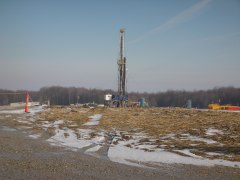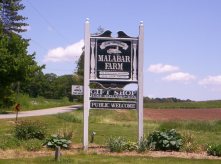(Posted by Grant Maki, OEC Attorney Of Counsel)
This is the first of a series of posts highlighting a few situations where a landowner could face liability for the conduct of a company that leases their land for natural gas drilling.
So you’ve signed on the dotted line to finalize an oil and gas lease, and now the trucks are rolling in and the drilling rig is being set up right there on your land. You hear all the machines humming and see workers connecting hoses to some of trucks lined up on the pad. For the first time, you realize just how much goes into drilling in the Marcellus shale. You start to wonder: what will happen if something goes wrong? Could you be left holding the bag for the cleanup of environmental contamination?
It turns out that you could. Congress enacted the Comprehensive Environmental Response, Compensation, and Liability Act (“CERCLA”, also known as “Superfund”) in 1980 to help clean up sites that have been contaminated with hazardous substances. The government can clean the contaminated sites and then use CERCLA to force the parties responsible for the contamination to pay back the costs.
Unfortunately for landowners, CERCLA can require payment from a very broad range of “potentially responsible parties,” including the owner or operator of a “facility” and the person who owned or operated a facility during which time the disposal of a hazardous substance occurred.[1] The term “facility” is defined as “any site or area where a hazardous substance has . . .come to be located”.[2] This has been interpreted by courts to include a the whole area around the contamination that had the same general function[3]—probably at least an entire well pad in the case of an oil and gas operation.
BUT ISN’T OIL & GAS EXEMPT FROM CERCLA? It is true that 42 U.S.C. § 9601(14) exempts petroleum and natural gas from regulation under CERCLA. It does not, however, exempt any materials that have been mixed with petroleum or natural gas, waste products from natural gas drilling operations, or chemicals brought in for use in such operations. See, for example, United States v. Gurley, 43 F.3d 1188, 1199 (8th Cir.1994) (limiting the exemption to crude petroleum products or refined products, and declining to extend the exemption even to used petroleum products.)
To make sense of these rules, let’s apply them to a hypothetical gas lease situation. Say the landowner signs a lease to allow a company to drill for gas on his land. The company drills the well, harvests the gas, plugs the well, and leaves. Then, years later, something happens. Maybe its a few cracks in the cement casing that is supposed to keep the hazardous chemicals that were forced underground from rising to the surface. Maybe one of the tanks that stored a hazardous substance developed a slow leak that was never noticed until the chemicals seeped through the soil all the way to a nearby creek. Whatever the cause, imagine that the contamination doesn’t becomes apparent until 30 years after the end of the lease.
If the site qualified for CERCLA, the government could come in and clean it up. Then it would look for potentially responsible parties to pay them back under CERCLA. Even though the landowner didn’t handle chemicals or drill the well, they are the “owner” of an “area where a hazardous substance has . . . come to be located”. That is enough to make them a potentially responsible party under CERCLA.
Now things start to get pretty scary for the land owner. CERCLA provides for strict liability for any potentially responsible party, without regard to who actually caused the contamination.[4] CERCLA also provides that all of the potentially responsible parties are held jointly and severally liable for the contamination—this means that the government can put the whole bill on any one responsible party and leave it to them to settle the allocation amongst the other parties.[5] This means that if the companies that caused the contamination have been dissolved, the landowner could be the only potentially responsible party left, and they would have to pay the entire bill.
It’s far past the scope of this blog post to get into the nuances of exactly when a landowner could be liable, and for how much. I’s also past the scope of this post to discuss how and to what extent landowners can protect themselves from CERCLA liability—that’s an issue for an individual landowner to bring up with their attorney.
Our purpose here was to show that landowners could be exposed to liability under CERCLA if their land becomes contaminated with hazardous waste as a result of a shale gas lease, even though it wasn’t their fault. Without the proper protections in the lease, the landowner could have to spend a considerable amount of time and money with a very qualified attorney to defend the case in federal court at the very least. At the worst, they could be left holding the bag for the entire cost of cleanup.
[1] 42 U.S.C. § 9607(a)(1) and (2)
[2] 42 U.S.C. § 9601(9)(B)
[3] See United States v. Twp. of Brighton, 153 F.3d 307, 312-13 (6th Cir.1998).
[4] State of N.Y. v. Shore Realty Corp., 759 F.2d 1032, 1042 (2d Cir.1985)
[5] J.V. Peters & Co. v. E.P.A., 767 F.2d 263 (6th Cir. 1985); U.S. v. ChemDyne Corp., 572 F. Supp. 802
(S.D. Ohio 1982).



